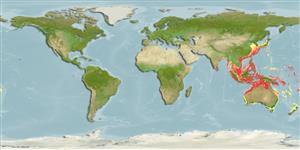Environment: milieu / climate zone / depth range / distribution range
Ökologie
seewasser demersal. Tropical
Eastern Indian Ocean: Indonesia and northwestern Australia (Ref. 5978). Also known from Papua New Guinea (Ref. 6192).
Size / Gewicht / Alter
Maturity: Lm ? range ? - ? cm
Max length : 16.5 cm TL Männchen/unbestimmt; (Ref. 3131)
Rückenflossenstacheln (insgesamt): 4 - 5; Rückenflossenweichstrahlen (insgesamt): 13-14; Afterflossenweichstrahlen: 12 - 15. A short black cirrus on eye. Respiratory valve inside lower jaw with a thread-like, pale appendage. Body without distinctive colour marks. Upper edge of opercle descending backward. Both nasal valves long and tubular. First dorsal fin with 4 (rarely 3) spines. Two basipterygial processes (Ref 42788)..
Life cycle and mating behavior
Geschlechtsreife | Fortpflanzung | Ablaichen | Eier | Fecundity | Larven
Sainsbury, K.J., P.J. Kailola and G.G. Leyland, 1985. Continental shelf fishes of the northern and north-western Australia. An illustrated guide. CSIRO Division of Fisheries Research; Clouston & Hall and Peter Pownall Fisheries Information Service, Canberra, Australia. 375 p. (Ref. 3131)
IUCN Rote Liste Status (Ref. 130435)
Bedrohung für Menschen
Harmless
Nutzung durch Menschen
Mehr Information
NamenSynonymeMetabolismusRäuberÖkotoxikologieFortpflanzungGeschlechtsreifeAblaichenSpawning aggregationFecundityEierEientwicklung
Alter/GrößeWachstumLänge-GewichtLänge-LängeLängenhäufigkeitenMorphometrieMorphologieLarvenLarven Pop.Dyn.RekrutierungDichteBRUVS
ReferenzenAquakulturAquakultur ProfilZuchtlinienGenetikElectrophoresesVererbbarkeitKrankheitenVerarbeitungNutrientsMass conversion
PartnerBilderStamps, Coins Misc.LauteCiguateraGeschwindigkeitSchwimmstilKiemenoberflächeOtolithsGehirngrößeSehfähigkeit
Tools
Zusatzinformationen
Download XML
Internet Quellen
Estimates based on models
Preferred temperature (Ref.
123201): 19.1 - 28.2, mean 25.9 °C (based on 791 cells).
Phylogenetic diversity index (Ref.
82804): PD
50 = 0.5000 [Uniqueness, from 0.5 = low to 2.0 = high].
Bayesian length-weight: a=0.00776 (0.00315 - 0.01914), b=3.09 (2.90 - 3.28), in cm total length, based on LWR estimates for this Genus-body shape (Ref.
93245).
Trophic level (Ref.
69278): 3.9 ±0.6 se; based on size and trophs of closest relatives
Widerstandsfähigkeit (Ref.
120179): hoch, Verdopplung der Population dauert weniger als 15 Monate. (Preliminary K or Fecundity.).
Fishing Vulnerability (Ref.
59153): Low vulnerability (10 of 100).
